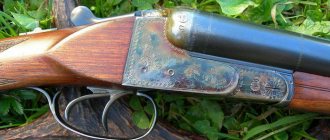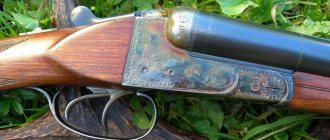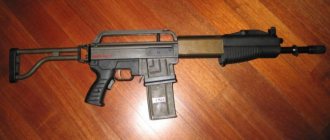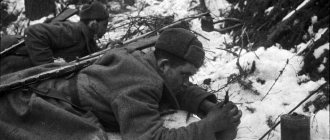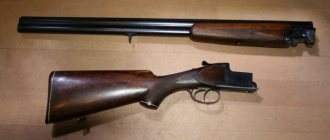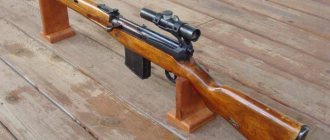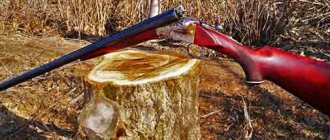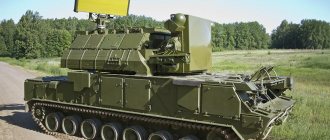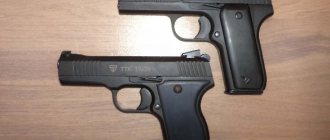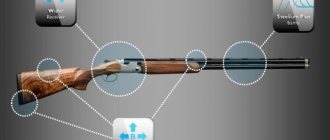IZH-54 is a popular gun among Soviet and Russian hunters. This type of double-barreled weapon was mass-produced at the Izhevsk Mechanical Plant from 1954 to 1970. Over almost 15 years of serial production, about half a million copies were produced, of which 70 thousand units were exported to countries near and far abroad.
The IZH-54 hunting rifle has proven itself to be a reliable and practical weapon. This allows him to be in sufficient demand among both experienced hunters and beginners. The owners speak fondly of the Soviet-made gun.
History of origin
After the victory in the Great Patriotic War, a large number of technical developments of German engineers were exported to the territory of the Soviet Union from Germany. Among the captured technologies were drawings and equipment from the German arms company JP Sauer und Sohn GmbH (Sauer & Sohn).
The design of the Sauer-8 rifle and the machines for its production helped to begin the serial production of the new Soviet hunting rifle IZH-49. Thus, the IZHMEX plant reached a higher quality level of shotgun production.
IZH-49 was produced from 1950 to 1954, after which it was decided to modernize this model, since it was heavy and not very well balanced.
After the modernization of the basic model IZH-49, a new development of the IZH-54 hunting rifle appeared. The improvements were introduced by small arms design engineer Leonid Ivanovich Pugachev. He made design changes, however, he chose to maintain the basic advantages.
The basis of the triple locking remains the same. The Anson-Delay internal trigger mechanism has changed, and updated sears have added durability to the design.
Other improvements helped the IZH-54 gun gain a reputation as a reliable and modern small arms. The modified design retained its Germanic roots.
Experiments
The main advantages of the new system were reliability and workmanship. After all, the fire tubes were made of a durable chrome-plated coating that did not give in to deformation and corrosion. However, the new system also had a disadvantage: it was very difficult to unscrew, which required the use of a special tool. With the development of technology, attempts have been made to eliminate this drawback. The weapon began to be produced under the names IZH-26 and IZH-26E. These guns, in their design, took all the best from the IZH-54 and 57 models, but the main difference from the old modifications was a significant reduction in the weight of the gun.
This was done thanks to a complete redesign of the Griner bolt mechanism, instead of which a locking bar was installed. Unfortunately, the production savings on the IZH-26 are very noticeable. These were the first guns from the Izhevsk plant, which did not differ from their competitors in quality and manufacturability. Due to the fact that the gun did not gain as much popularity as its predecessors, it was replaced by the IZH-58.
Design
The barrel blanks of the IZH-54 gun were made from 50A weapon steel. The metal alloy underwent thorough heat treatment and the barrels were immediately drilled out. This technology took a lot of time and labor costs were high, but the result was the highest quality of manufactured parts.
Over time, the labor-intensive technology was replaced with a simplified one, using the “hot forging” method, which led to a decrease in the quality of the guns produced.
Models produced from 1954 to 1960 had barrels soldered together with hard solder and interbarrel strips.
Since 1961, changes have been made to the connection technology. Now the barrels were attached to a coupling, which simplified installation and reduced the cost of the process. Brief characteristics of the barrel:
- caliber - 12, smoothbore;
- length 730 or 750 mm;
- chamber length 70mm;
- barrel channel diameter 18.5 mm and 18.9 mm;
- parabolic choke: right choke 0.5 mm and left full choke 1.0 mm.
The surface of the trunks was covered with one of the following compounds: chrome, nickel or a special layer of paint. The difference in surface treatment was small.
The only thing is that with chemical coating, the gloss looked duller and the resistance to high moisture was less than other methods of external processing of steel. This coating method was used throughout the 60s for all produced copies.
Until 1954, bores were not chrome-plated.
It was only in 1955 that chrome plating technology was first used. The processing process was selective, and only one-piece specimens were subjected to it. Information about the coating was not included in the gun's passport. Beginning in 1958, records of chrome plating began to appear in the document.
The block went through the following manufacturing process: all soft metal parts were fitted and then carburized. After which the parts assumed the required strength.
Recommendations for storing IZH-54
The service life of any gun depends on the conditions under which it is stored. In order for the IZH-54 to serve for a long time, the following rules must be followed:
- The weapon can be stored disassembled or unassembled in a dry room (for example, in a pantry);
- IZH-54 mechanisms should never contain dirt or foreign objects; active parts should always be covered with a thin layer of lubricant;
- To prevent the mainsprings from being seated, the hammers must be released during storage;
- After shooting, cleaning should be carried out as soon as possible. During the cold season, it can only be done in a warm room, when the gun warms up to room temperature;
- The gun must be cleaned within 4-5 days after shooting, until there are no more traces of dirt and soot on the rag;
- The bores of the barrel can only be cleaned with soft rags and napkins. Do not use abrasive materials for cleaning;
- After intense shooting, it is recommended to wash the barrels in warm water to get rid of a large amount of carbon deposits. After washing, they must be thoroughly wiped using rags and napkins. During the wiping process, they must be constantly changed to clean and dry ones;
- Leaded steel is cleaned using a brush with soft metal bristles and gun lubricant, which is applied to the cleaning rod;
- Cleaning of IZH-54 takes place in disassembled form.
Regular maintenance of your gun will extend its service life. Without regular cleaning, small mechanical failures can occur, which can lead to serious defects in the future that will take a lot of time and money to fix.
Appearance
The designers paid great attention to the quality of the weapon, so the aesthetic design of the gun remained below average. We tried to add beauty in the following way: stamps of animal images and simple patterns were applied to the metal plates. Technical information was applied by engraving.
To add individuality to the one-piece models, skilled craftsmen were hired to apply various engravings on the metal plates and on the butt. But this did not help rid the gun of its rough appearance.
Moreover, high-quality individual design by a master was very rare. There is an opinion among IZH-54 owners that engraving on a gun is generally inappropriate.
Gift copies were decorated at a high artistic level.
The decoration used the method of tauching with precious metals, gold and silver. The quality of the engraving was distinguished by its clarity and depth.
Decorated examples were classified as souvenirs, but this did not prevent them from having all the standard characteristics of small arms.
The IZH-54 hunting rifle has a classic butt design. It was made from walnut or oak. There was no difference in appearance. The characteristics were as similar as possible. Excellent wood processing technology allowed the stock to maintain its original appearance for many years.
It did not dry out or crack with any use. The stock is fitted to steel parts with high precision. It was equipped with pads in the form of a heel and a rosette on the pistol grip.
Design features
The hunting model IZH-54 inherited the features of its predecessor, diluted with new elements. The basis remained the triple locking option on the frame and the Griner bolt, which were characteristic of the products of the German manufacturer in the first half of the twentieth century.
The classic version of the mechanism with plate-type mainsprings has undergone significant changes in the form of more modern sears located below. This measure only strengthened the block.
The indicators of the trigger mechanism, like the stock, are chrome-plated and shifted from the sides of the block to its upper part. This made it easier to distinguish them in the twilight and check them by touch. The firing pins were separated from the hammers and placed in chrome fire tubes.
A reliable automatic safety locked the triggers and sear at the same time.
50A steel was used to create barrel blanks. Alloy metals were subjected to serious heat treatment, and the workpieces were immediately drilled into barrels. This technological method required a lot of time and serious labor costs, but in the end the parts produced were of a quality that was found to be excellent.
After some time, the complex technology was replaced by a simplified method of hot forging, lowering the quality indicators of hunting weapons.
The model range, produced between 1954 and 1960, had rigidly welded barrels with an interbarrel strip.
Connection technology has evolved since 1961. The barrels began to be fixed to the coupling, simplifying their installation and reducing the cost of the gun. The main characteristics of the barrel are:
- caliber – chambered for 12;
- length – 73 (75) cm;
- channel diameter – 18.5 (18.9) mm.
The barrel surface was coated with chrome, nickel or a special coloring compound. There was no particular difference in this treatment, only the paint looked duller and was exposed to moisture faster.
Ammunition used
For the IZH-54 shotgun, hunters and athletes use various types of 12-gauge cartridges, which differ significantly from each other. To make it easier to understand shooting ammunition, they are divided into three types:
- shotguns (standard, reinforced, sports)
- buckshot;
- bullets.
Shot charge
A larger cartridge caliber guarantees a larger number of pellets. The usual size of striking elements is from 1.5 to 5 mm. The 12 gauge cartridge is considered rather large and the recoil after the shot is very noticeable. The more powerful the recoil, the less accurate the hit. Recoil depends on the amount of gunpowder.
Purchased cartridges are more or less balanced in terms of the amount of shot and gunpowder. And when loading cartridges with shot on their own, professional hunters take into account that the large weight of the charge reduces its initial speed and firing distance.
Such ammunition can be used at close range. Well, and vice versa, respectively. However, too little shot dramatically reduces the chance of a hit. For this reason, most hunters adhere to the recommendations. Most, but not all. buckshot
Buckshot ammunition is loaded with shot from 5mm.
In this case, the fraction can be either consistent or inconsistent. In addition, the damaging elements can be soft or hard.
Soft shot is used for shooting at short distances, and hard shot is used for shooting at a distance. Depending on this, the hunter selects the optimal ammunition option.
Bullet
This type of ammunition is used for hunting large animals. Although for this it is better to use a rifled carabiner. But the hunt for large animals with an IZH-54 gun was and is ongoing. Depending on the size of the game, the bullet weight is selected.
The larger the animal, the correspondingly heavier the bullet. Its weight can reach up to 40 grams. A special feature of a bullet is its deformation when it hits an animal. To catch small game, lighter striking elements from 25 to 28 grams are used, which do not have the property of being deformed.
To shoot prey at a distance of 50-60 meters, a heavy caliber bullet with a belt is used. Its distinctive feature is its destructive power.
Ammo manufacturers
It is not even possible to select several companies producing 12-gauge cartridges with positive reviews. The products are in demand among regular customers, but there are also those who do not like the ammunition.
Each hunter chooses ammunition from a certain manufacturer for himself, based on personal use.
It can definitely be said that the quality of Russian cartridges is becoming competitive and in some cases superior to foreign analogues.
Rules for using a gun
The manufacturer strictly recommends adhering to a number of rules specified in the technical passport of the weapon. This will increase the life of the rifle and avoid dangerous situations.
when preparing to load the rifle, check the barrel bore for the presence of unnecessary elements: debris, dirt, etc.; Be careful about the safety of gun barrels. Avoid mechanical damage and deformation of this part; It is not recommended to pull the trigger on an unloaded weapon; open the rifle barrels smoothly
Avoid releasing barrels freely; if the cartridge does not fit into the chamber, then change the ammunition; It is strictly not recommended to use a capsule with a missing powder charge; the barrels have a muzzle constriction. Therefore, be careful when choosing bullets for cartridges; Pay close attention to the power of the powder charge in the cartridge. Do not exceed the values specified in the passport.
Guided by the above rules, even a beginner can avoid most problems with weapons.
When and by whom was it released?
The IZHMEH weapons company produced a fairly large number of modified IZH-54 models. Two types were production versions, and the rest were converted models.
The basic versions were the main type of gun. Basically, the entire production cycle was mechanized. Handwork was used to apply stamped images and drawings. The cost of the basic version was 90 rubles. Depending on the build quality, the price could reach up to 120 rubles for an IZH-54 gun.
Piece models were designated by the letter “Ш”. Its modified copies were designated as: Ш1 and Ш2. These one-off specimens had high-quality barrel alignment and excellent hit accuracy.
In addition, the weapon featured an exclusive design and engraving with images of birds and animals.
The forend and stock were made from valuable walnut species. The trigger module was plated with chrome.
The second basic version of the IZH-54 was a souvenir version of the gun. It was significantly distinguished by its handcrafted quality and individuality. The price for this type of weapon exceeded 200 rubles.
An experimental model of the IZH-54 shotgun with a 16-gauge barrel was produced in a very small batch. Today it is almost impossible to find this option.
The IZH-54 “Sport” is also a rare model. This modified specimen was manufactured to special orders and included two pairs of barrels of different lengths.
The good technical characteristics of the gun made it possible to begin export production of weapons. This type did not have expensive finishing. The inscriptions “Made in USSR” were written on the sides of the pads.
Evolution of weapons
In 1957, the same Pugachev created a new gun, IZH-57. However, this did not lead to the closure of the old model. Quite the contrary! The new gun was produced in a small quantity (only 20 thousand pieces), but it became an experimental weapon on which various new developments were installed. As soon as customers liked these innovations, they were immediately installed on the IZH-54.
Also, throughout production, many innovations were added that were developed specifically for the IZH-57. These innovations include the hammer release mechanism, which was transferred from one gun to the second almost immediately after the 57th was put into operation.
Also, in connection with the production of IZH-57, new, more modern barrels and fire tubes were installed on the 54 model.
On early models of IZH-54, strikers were installed that protruded from the solid mirror of the block when the triggers were pulled. It was believed that triggers without a release made it difficult for the system to open the gun after shots. The system was replaced with a more modern version from the 1957 model.
Gun design features:
- triple locking barrels;
- durable steel box;
- hardened parts of the mechanism;
- thickened barrels, which made it possible to use a powerful charge for shooting;
- a common extractor for both barrels;
- the trigger releases easily and smoothly;
- quick assembly and disassembly of weapons.
Owner reviews
The IZH-54 smoothbore gun has positive reviews from its owners. They claim that in most cases the gun never failed. However, there were funny situations. One of the hunters said that when he was hunting hares in winter, the weapon began to fire double shots.
The recoil was so strong that the shooter's shoulder was knocked off and his lip was broken.
Returning home, he disassembled the block. The cause was discovered immediately. It turned out that the lubricant of the striking mechanism had thickened and did not allow the trigger to move into place. By removing the excess lubricant, the problem was solved.
More than half a century has passed since the start of production of the IZH-54, and interest in it has not waned, on the contrary, it has grown. It’s difficult to say what this is connected with, but it’s worth assuming that hunters are attracted to Soviet quality. The price for them is still quite high, and this is after 60 years of operation.
Modifications
The IZHMEH arms factory produced the IZH-54 double-barreled shotgun quite a long time ago, so it is not surprising that over more than half a century the model has acquired a solid list of modifications. Unfortunately, many of the samples were produced in single-piece versions and today can only be purchased secondhand from the current owners. The serial versions were only two double-barreled shotguns: the popular IZH-54 and the legendary IZH-58. You can find them today in almost any gun store. The modifications have the following prefixes in their names:
- "Sh" - obese. Most of the currently existing models are designated as IZH-54-Sh1 or IZH-54-Sh2. Such weapons are distinguished by their exclusive design and also have more impressive combat accuracy (up to 75%) due to the high-quality alignment of the barrels. The forend and stock of the double-barreled shotgun are made of high-quality hazel, which is painted red, and the main metal module is chemically coated. An excellent weapon for a collector and connoisseur of beauty.
- "16K" - 16 gauge. This IZH-54 was produced in a very small batch, so it is almost impossible to find such a model on the open market. The gun was positioned as universal (suitable for hunting animals and birds), but during production something went wrong and the double-barreled gun began to be significantly inferior to its analogues in terms of combat characteristics. However, the IZH-54-16K is highly prized by collectors for its rarity, as well as its unique carved metal design.
- "Sport" - sports. Another very rare modification, which has an enlarged barrel and lower shot power. The trigger of the IZH-54 “Sport” model is even softer, so the weapon began to be actively used by professional athletes for training and participation in competitions. Unfortunately, after several decades of active use, there are not many complete guns of this type left in the world.
And these are only those modifications that are considered the most unique and rare. There are also many samples with an enlarged or shortened barrel, a plastic butt instead of a wooden one, and even an installed sighting bar. IZHMEH continues to support the production of IZH-54 and IZH-58 to this day, so it is not surprising that the weapon continues to receive various improvements.
